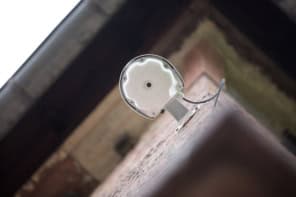Robert P Crease beholds a pitilessly precise 3D model of his near-naked body as he discovers a new application of physics in the consumer marketplace
![A [TC]2 scan of the author](https://physicsworld.com/wp-content/uploads/2010/09/bod1.jpg)
Earlier this summer I witnessed a showdown between two advanced optical-imaging technologies. It took place in Haverhill, Massachusetts, where the famous US clothing chain Brooks Brothers operates its Southwick manufacturing plant. The event was organized by Joseph Antista, Southwick’s director of training, who had two 3D-body-scanning companies set up their latest models. Being a fan of physics in the marketplace, I decided to attend.
The rivals were the Tailored Clothing Technology Corporation or [TC]2, which is the US market leader in body-scanning, and Human Solutions, a German firm that is the world market leader. The [TC]2 model stood to the left, a black, closet-like booth about 2 m high and about 1.2 m by 1.5 m. To the right was its challenger, consisting of three 3 m towers positioned in a triangle about 2 m on each side. Each device had been designed by a team that included several programmers and engineers and, as it happened, a physicist. Each required an hour to set up, but could be plugged straight into an electrical outlet. Each needed but a few seconds to scan a customer.
Fitting is a dying art, Antista told me, and hand measuring is time-consuming and expensive, which is why he was testing the two devices for possible use in Brooks Brothers’ 100 or so stores and numerous outlets. (Cyberware, a distant competitor based in Hollywood, caters to a more hi-tech niche.)
While Antista studied the data, I ran my own independent test.
Body image
I tried [TC]2 first. Its technology, dubbed “Structured Light Assisted Stereo 3-D Sensing”, uses 16 pairs of cameras that triangulate the positions of points of light projected onto the body. I undressed in a changing room, put on a neutral-coloured garment called “scanwear” and stepped inside.
A pleasant recorded female voice in_structed me to stand in place, grip the handholds and push a button. Lights flashed, projecting patterns on my body while the camera gains were optimized for my skin colour. Then the image-acquisition process began, with striped patterns used to “structure” the imaging to facilitate triangulation. While stereo sensing with white light is a well-known range-finding technique – it was used, for instance, on the Mars Rover, where a pair of cameras gauged distance – a lot of computing power is needed to calculate the locations of hundreds of thousands of positions on the body in a few seconds. Only recently have computers became fast and cheap enough to be used in body-scanning.
The experience was “quick, easy, safe, private”, just as the [TC]2 vice-president for technology development David Bruner assured me. The device has no moving parts. To use white light, Bruner explained, the technology was optimized for scanning human beings in upright poses. [TC]2‘s scanners are already found at numerous US universities and clothing stores, and at several UK institutions, including University College London Hospital, where it helps researchers to study obesity and children’s health issues.
Then I tried the Human Solutions device, which uses lasers rather than white light. Roy Wang, a Human Solutions representative who studied physics at the University of Toronto, explained that triangulation is easier with lasers because the measurements are more precise – though some markets, such as the US, unreasonably fear lasers for alleged safety reasons. Each of the three towers in the device has a laser and camera on a moveable mount. As I was scanned, the mounts slowly descended, projecting a horizontal red line that the cameras used to acquire my body’s cross-section.
Both technologies produced a data cloud of hundreds of thousands of points, sorted them into a 3D model, extracted key measurements and produced an “avatar” – an aesthetic, skin-covered visualization that could be used to simulate how clothes would look on it. Both machines had a comparable measurement accuracy. The [TC]2 machine is somewhat cheaper and optimized for clothing. The Human Solutions model is optimized for research purposes and can also measure bodies in a sitting position. It has found applications in ergonomic research, such as at NASA’s Houston facility, where it is used to map the bodies of astronauts in various positions.
Both machines can simulate moving avatars. “Women, being curvier than men, may want to see how belts and appliqués [decorations] will look in different positions while in motion,” Wang told me. “It’s not trivial!” He then put a belt and an appliqué on a simulated female avatar, and varied the properties of her clothing, such as the fabric’s elongation, compression and bending rigidity. The look changed dramatically. “Now watch this!” Wang tweaked the dials so that the simulated woman’s clothes caught on a tree branch, and we watched how that particular fabric reacted when snagged.
The critical point
In each case, the one negative moment of my experience was seeing a pitilessly precise 3D model of my near-naked body. My reaction was not untypical, Antista explained. “The technology’s too good!” he laughed. So to avoid the embarrassment of looking at one’s unclothed body, customers will be shown already dressed in their desired clothing.
I asked Antista if the 3D measurements were inferior to those of traditional fitters. “Their skill was not in the measuring,” he replied. “It was in knowing what would happen when you clothe a person. A measurement simply helps a fitter decide, ‘What am I going to put on her?’ A person is not a piece of wood. A person is alive.”
Antista picked up part of a suit that a seamstress was preparing. “See the fabric? It’s alive, too. It has seven layers of different fabric that react differently when it moves, and changes when it’s cleaned. A suit is also not a piece of wood.”
Whatever consumers may think of 3D body-imaging, one thing is clear: its entry into custom-made tailoring is another great example of how massive, cheap computing power is making hitherto hi-tech applications of physics more routine.



